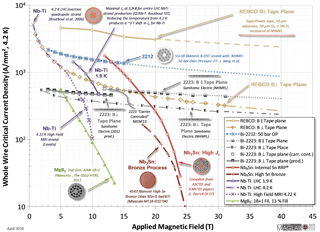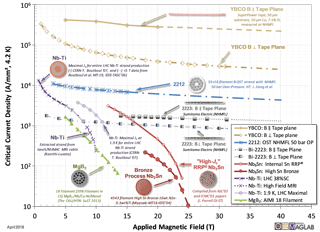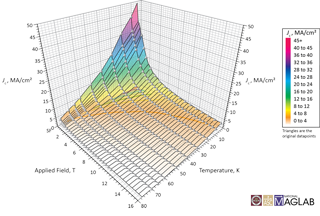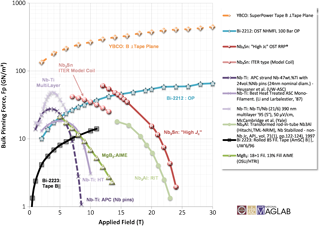The expanded ASC "Plots" page.
The official ASC "plots" page was most recently at: https://nationalmaglab.org/magnet-development/applied-superconductivity-center/plots
Unfortunately the location of that page is not always static and takes some time to update. If you find that it has moved please .
| A comparison of Superconductor Critical Currents | |
 |
Engineering Critical Current Density vs. Applied Field: April 11th 2018 1024x743 113 kB PNG Suggestions/corrections are always welcome. |
References: |
|
 |
Non-stabilizer Critical Current Density vs. Applied Field: April 11th 2018 1920x1393 232 kB PNG References: See Je plot. You can add your own data to the plot using the Excel Worksheet: Suggestions for newer and better data are always welcome. |
Edited version of comparison between Bulk Pinning Force and Field of a Superconductor124 kB 1396x987 PNG |
|
 |
Critical Surface of YBCO Tape256 kB 1277x836 PNG280 kB 1277x836 jpeg Superpower YBCO Data measured at NHMFL by Aixa Xu at NHMFL, March 2011. H ∥ C (⊥ tape surface). |
compiled the data and generated the graphs
| Nb3Sn Scaling Spreadsheet - Matthijs Mentink, Diego Arbelaez, Arno Godeke [LBNL] | |
|
|
|
 |
Scaling Spreadsheet - V5 Jan 2010 89 KB Scaling Spreadsheet: Excel Format |
Adobe Acrobat© Reader™ Required to view the papers. ![]()
Daniel's XL Toolbox was used to generate some versions of the plots from Excel.

